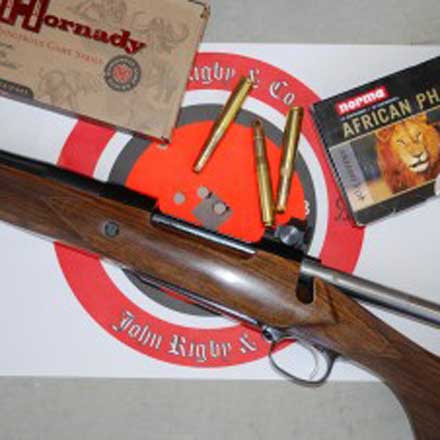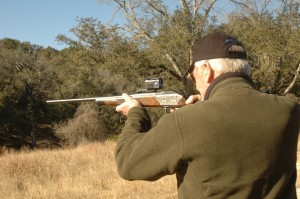
Among American hunters, open sights are almost obsolete. As I’ve written before, I genuinely believe they have their purposes, but they are very limited. It’s axiomatic that you can’t hit something if you can’t see it, and telescopic sights, rifle scopes, enable you to see better. Telescopic rifle sights have been in common use since the 1950s, and almost universal during my entire hunting career which began in the 1960s. I do believe there is great value in learning to shoot first with open sights. There is really no substitute for the lessons in precise sight alignment and sight picture that must be learned to effectively shoot open sights. But that’s swimming against the tide. These days, most new hunters start with scopes and have little (or no) exposure to open sights.
Open sights are difficult to use and require the eye to do a great deal of work focusing back and forth between rear sight, front sight, and target. As we get older, our eyes become less flexible, and at some point, like about where I am now in my late 50s for example, it becomes almost impossible for the eye to properly resolve a sight picture with open sights. Traditional open sights—some kind of a “V”, “U-notch” or “buckhorn” rear with a bead or blade front sight—also become impossible to use in low light, whereas telescopic sights gather light and enable accurate shooting during those critical minutes of first and last legal shooting light. On the other hand, there are many fast-breaking situations where the magnification of a telescopic sight is not needed and may even be detrimental, but the ability to find the aiming point and see the target clearly remains critical.
We often interchange the terms opensights and iron sights, which I have so faravoided in this article. An open sight is as described above. It is an iron sight, which means essentially without glass, but there is another iron sight: The aperture or “peep” sight. Although the peep sight contains no glass, it is actually an optical sight in that the eye naturally and automatically centers the bead or tip of the blade in the center of the opening. The eye is able to ignore the rear sight, the aperture, and simply superimpose the front sight on the target. In other words, the eye only has to work in two focal planes, the front sight and target, whereas open sights require the eye to work in three focal planes (rear sight, front sight, target). Using an aperture sight...
takes practice (what doesn’t?) and works best with a stock that fits. But once you get used to it, the aperture sight is absolutely faster than an open sight and much easier for middle-aged eyes to use.
Aperture sights, especially with larger apertures (“ghost ring” sights), are better in low light than open sights, but still not nearly so good as a scope because they gather no light. They also require the eye to work in two focal planes. A scope allows the eye to work in just one focal plane: Superimpose the reticule on the target and squeeze the trigger!

This leads us to another class of optical sight that is not a telescopic sight, the so-called “red dot” sight. Some of these, like the new Aimpoint “Hunter,” look like a telescopic sight in that you look through a tube. Others, like the red-dot sights from Bushnell, Trijicon, Zeiss, and many other scope and sight manufacturers, look like an iron sight. No to both. The red dot sight is not a rifle scope with an illuminated reticle, and it is not an iron sight. As the catchall-name implies, the red dot sight uses a centered point of light as the aiming point. There is no magnification. The lighted aiming point can be moved, adjusted, or “zeroed” to coincide with the strike of the bullet.
Obvious advantages are that, just like a scope, the eye only has to work in one focal plane. Superimpose the lighted dot on the target and squeeze the trigger. This makes them excellent for older shooters like me who can no longer resolve open sights. They are not long-range sights because of the lack of magnification, but at closer ranges, the degree of precision they allow is simply amazing. The lighted aiming point makes them excellent for low-light use, and perhaps their greatest attribute is they are very, very fast. The Swedish Aimpoint was probably the original, designed initially for the fast driven shooting so popular in Europe. I tend to think the other red-dot sights evolved from a myriad of competitive shooting disciplines, but any and all are extremely useful in any situation where shots are fast and close.
This ranges from practical pistol competition to close-quarters combat and to a lot of hunting...
applications. Situations that come to mind include not only shooting driven game, but any hunting with hounds, wild turkey hunting, and even hunting dangerous game. Two friends of mine, professional hunter Joe O’Bannon and his long-time client and friend, Joe Greenfield, both hunt African dangerous game with double rifles. Unlike most of us who refuse to accept the inevitable, they came to grips with the fact that they were having trouble resolving the double rifle’s traditional “express” open sights. Their classic English doubles are now fitted with Bushnell red-dot sights. Yep, looks pretty weird and for darn sure is non-traditional, but you can’t shoot if you can’t see, and the red-dot sights allow you to see. Fast!

Just recently, I put an Aimpoint Hunter on an E.R. Shaw bolt action in .35 Ackley Improved, a great rifle for wild hogs and black bears. Low-light visibility is fantastic and even without magnification, I have been simply amazed at the tight groups I’m able to shoot with this sight. Absent magnification, I probably need to keep my shots within 150 yards, but that pretty much covers all the wild boar and black bear shooting I’m likely to do. I’ve long been a great fan of aperture sights, but I have to admit that the red-dot sights are a much better mousetrap, especially in low light, and darn it, they're especially good tools for my middle-aged eyes!